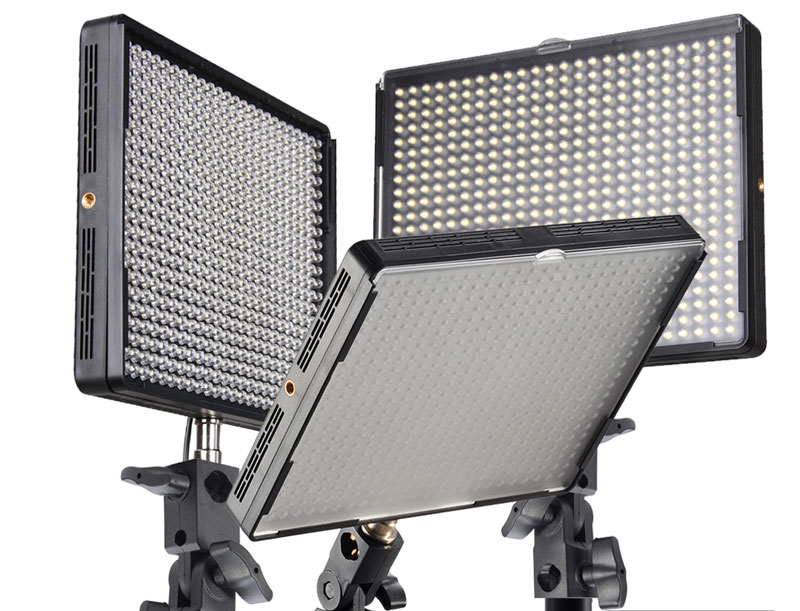Aputure Lights: Amaran vs Lightstorm
In a very short amount of time, Aputure has changed the game for LED panel lighting solutions for video producers. In addition to the assortment of lights they already offer, Aputure is also coming out with new lights all the time. And the good news is, they’re all really affordable. So then, how do you choose which light or lights to get for your productions?
In this post we're going to break down the Amaran and Light Storm options and make recommendations based on various factors. At a basic level, we're only talking about using these lights for interview setups or for lighting simple B-roll scenes.
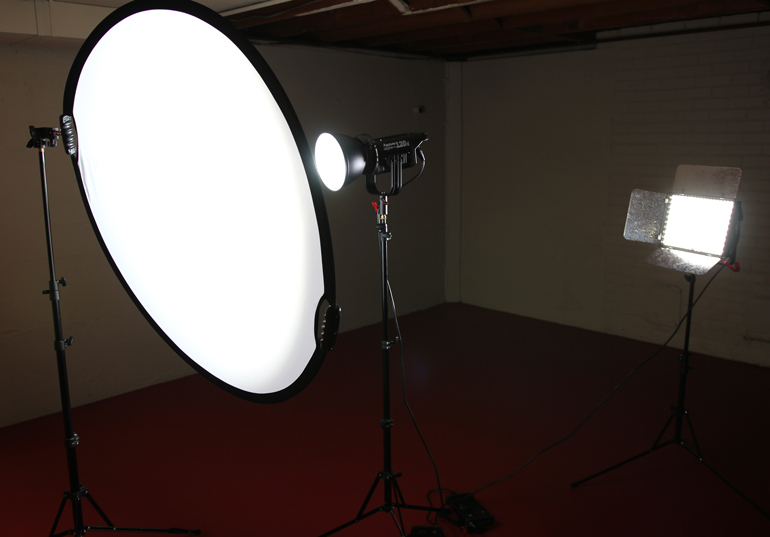
For anything more complicated that requires more light intensity, consider the Light Storm COB-120t, which is a super bright and highly modifiable tungsten light, or the Light Storm COB-120d, the daylight version which we write more extensively about in this article.
Or if you need the ultimate in light output and power, the Aputure 300D outperforms everything in its price point. Here's our Aputure 300D review.
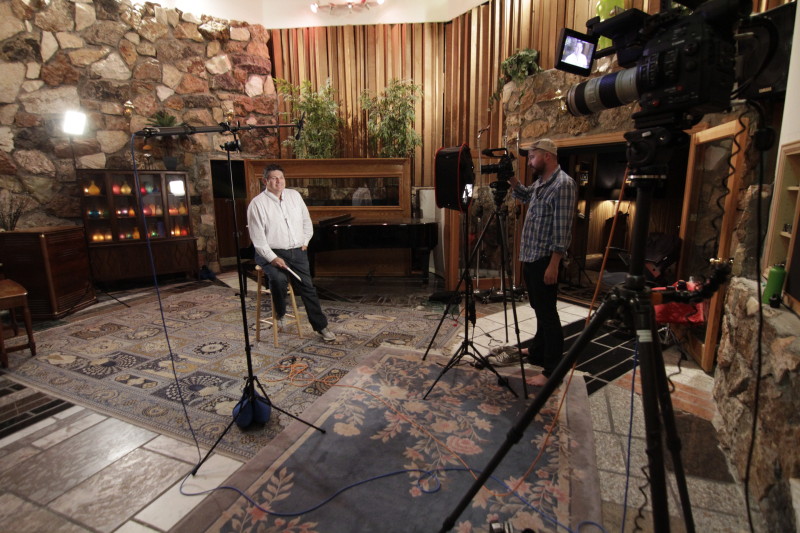
Light Storm LS1C in a D-Fuse Softbox, with an Amaran 672W in the background.
In the above photo, we were shooting an interview at Robert Lang Studios in Seattle. It’s a typical interview setup, where you would use your most powerful light as your primary or key light, ideally with a diffuser of some sort (here we’re using the very convenient D-Fuse Softbox). And then you use your smaller less powerful lights as a rim or hair light, or to fill the background a little.
You might also want to use a fill light on the subject, to soften the shadows created by your key, but truthfully in most cases we don’t setup a traditional 3-point lighting scenario for interviews in the field, where often there is some kind of ambient light anyway. It would be a different story if you were interviewing in a pitch black studio space where you control all the light.
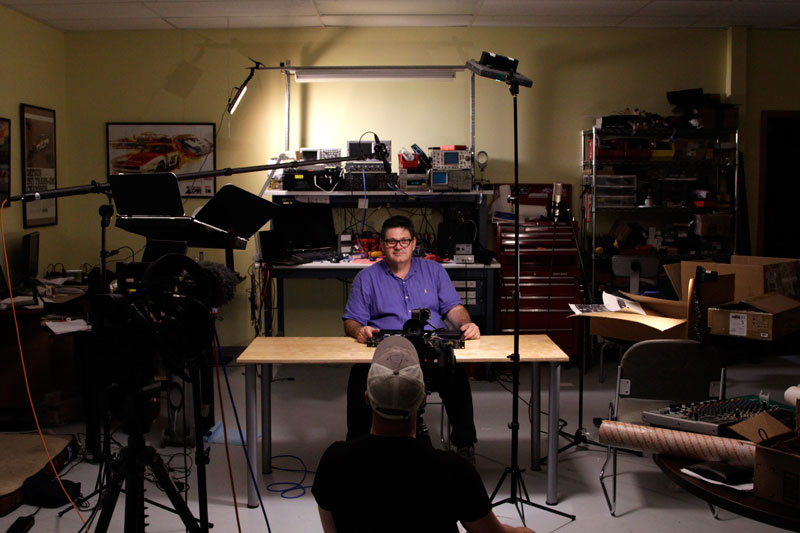
Light Storm LS1C bouncing off the ceiling, with Amaran 672W in the back and over the table.
Here’s another setup that we typically use for training or demonstration videos, where we position our most powerful light on the subject or bouncing up on the ceiling, and our less powerful but nimble lights to create dimension in the background, and to point light down on the table from an overhead position.
So in these two situations, all things being equal, we would use our Light Storm as our key, and a couple Amaran lights for other duties as assigned. But is that the case every time? And which Light Storm and Amaran variety do you choose? More on that in a moment.
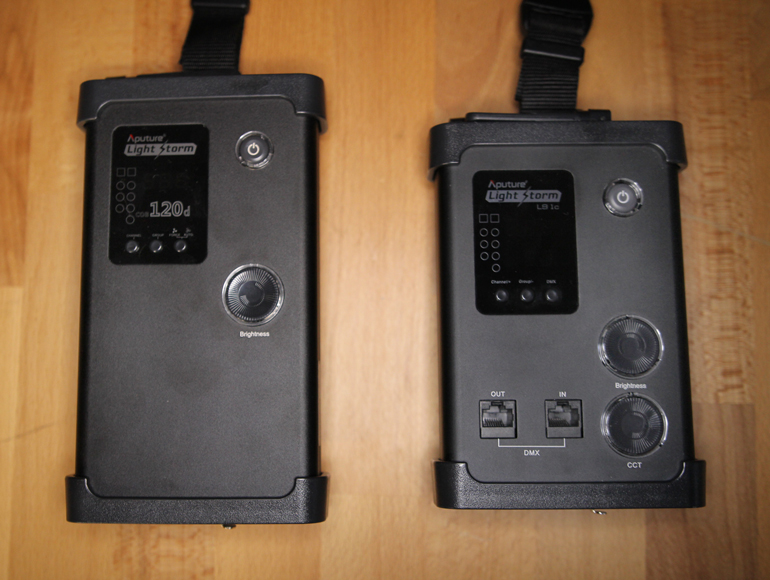
Here is a situation completely different from an interview or tabletop setup, but hey, when you’re a video producer, often you get called on to produce all kinds of videos. And you need to be flexible. Will it be inside or outside? How many people are we lighting? What does the blocking look like?
When you are tasked to go into an unfamiliar situation, you want to come prepared with the most powerful, portable lights you have. Because you just never know. And unless you carry a lot of gels, bi-color is often a life saver in these kinds of mystery shoots. This is where the Light Storm LS1C is incredibly useful to have around.
Ok so let’s break down the numbers first, and then we’ll talk recommendations.
Aputure Amaran 528
Amaran AL-528W – W standing for its 75-degree Wide beam angle. 528 LEDs, 1220 lux at 1 meter. Daylight but comes with a Tungsten filter. Weighs 1.2 lbs, powered by AC or 2 Sony NP-batteries, completely dimmable.
Amaran AL-528S – S standing for its 25-degree Spot beam angle. 528 LEDs, 4380 lux at 1 meter. Same weight and power.
Amaran AL-528C – C standing for bi-color. 528 LEDs split between tungsten and daylight, so you can dial it in between 3200K to 5500K. Same weight and power. But because there are now 264 Tungsten and 264 Daylight bulbs with the same beam angle as the 528W, the max brightness is 725 lux at 1 meter, and that’s with the color dial set somewhere in the middle at about 4300K with all the LEDs engaged equally. At full daylight, you can expect half the output of the 528W, so about 610 lux at 1 meter.
All the Amaran 528 LED panel lights come with a bag, a diffusion filter, a very handy tilt-able light stand adapter, and an AC adapter.
Aputure Amaran 672
Amaran AL-HR672W – W standing for its 75-degree Wide beam angle. 672 LEDs, 2080 lux at 1 meter. Daylight but comes with a Tungsten filter. Weighs 1.3 lbs, powered by AC or 2 Sony NP-batteries, completely dimmable.
Amaran AL-HR672S – S standing for its 25-degree Spot beam angle. 672 LEDs, 6040 lux at 1 meter. Also daylight, and has the same weight and power.
Amaran AL-HR672C – C standing for bi-color. 672 LEDs split between tungsten and daylight, so you can dial it in between 3200K to 5500K. Same weight and power. But because there are now 336 Tungsten and 336 Daylight bulbs with the same beam angle as the 672W, the max brightness is now half the 672W at daylight, or about 1040 lux at 1 meter. Aputure specs say the max brightness when both sets of bulbs are engaged, with the dial set to about 4300K, is 1920 lux at 1 meter.
All the Amaran 672 LED panel lights come with a bag, a diffusion filter, a very handy tilt-able light stand adapter, two large Sony NP batteries, and an AC adapter that can actually charge the Sony batteries when they’re inserted, which is so clever in that it saves you from carrying a separate Sony battery charger.
The 672 lights also come with a remote control, and you can setup multiple lights to run off one remote, allowing you full control of brightness and color while you’re standing behind the camera, watching the image. The remote is also handy when you want to setup all the lights, and then turn them off to conserve battery during the breaks when you’re not shooting.
Aputure Light Storm
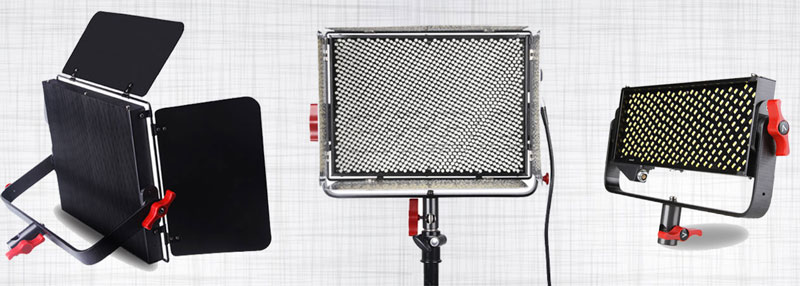
Light Storm LS 1S – the daylight version, with a 25 degree beam angle. 1536 LEDs, producing 10,500 lux at 1 meter. It comes with a controller box that is physically separate from the light, so that you can place it on the ground or around the light stand rather than adding more weight to the light. However, the light itself is 5.5 pounds. All together with the controller it’s about 11.5 pounds. The controller box can accept a battery (which of course adds even more weight), and you can get it in either the Sony V-mount version, or the Anton Bauer version.
Light Storm LS 1C – the bicolor version, with a 45 degree beam angle. 1536 LEDs, with a max brightness of 7500 lux at 1 meter, but that’s with the color dial in the center at about 4300K. At full daylight the brightness is half the output of the LS1S, and adjusting for a slightly wider beam angle, it’s more likely around 5000 lux at 1 meter, but we can’t say for certain what the actual spec is. The point is, there are only 768 Daylight bulbs, so expect about half the brightness of the LS1S at Daylight.
Light Storm LS 1/2W – this is a daylight-only version that is half the size of the other Light Storms, and with a wide beam angle of 120 degrees. It has 264 LEDs with an output of 1100 lux at 1 meter. The controller box and battery and build quality is all the same, but the LS1/2W doesn’t have barn doors, as it’s meant to be a powerful flood light. Together with everything (except batteries) it weighs 6.7 pounds.
All the Light Storm LED panel lights have built in yokes, so you don’t need a tilt-able adapter for a light stand.
UPDATE: Recently Aputure released a new series of Amaran panel lights called Tri-8, that not only have 888 LEDs, but feature the heavy-duty aluminum build quality that the Light Storm series have. But they’ll still be light weight, portable, and run off Sony NP batteries.
Check out the various Aputure Tri-8 packages here.
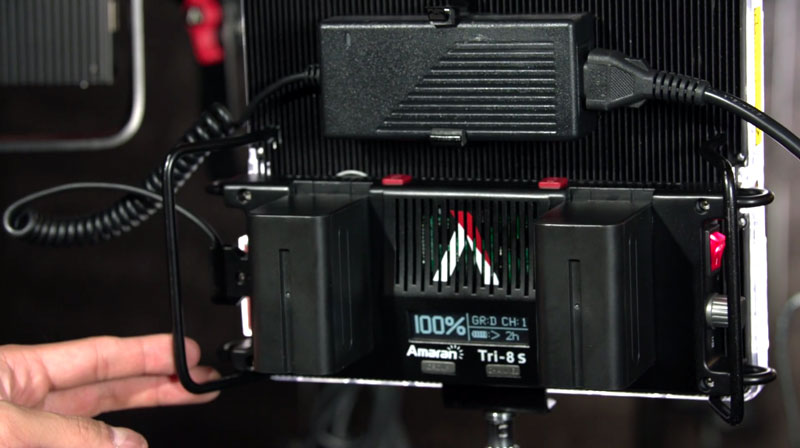
So, as a basic comparison between the two series, the Amaran lights are incredibly light and take up very little space or weight, but they’re still powerful enough to use as key lights for interviews. They are so light, even with batteries, that you can attach them to anything with a Gorillapod little tripod or Dinkum clamps. The plastic build quality, however, is not meant to take a lot of abuse, so you can’t expect the same level of build as similarly spec’d lights that cost 10x as much.
The Light Storm lights, on the other hand, have the build quality of other 1×1 lights that are priced 3-4x as high. And because the LEDs are arranged in a honeycomb pattern, the Light Storm packs a ton of light output in a small package. And having the controller box separate from the light means the LEDs can stay cool with the rear vents, and you can still use very portable light stands (we use the Manfrotto Nano Stand 5001B) and place the controller on the floor or around one of the light stand knobs.
The disadvantage with the Light Storms is they are so much bigger and heavier than the Amaran lights, with a lot more parts and pieces. So unlike the Amarans (which are easy to bring around everywhere, even if you don’t plan to use them), you’ll have to think more seriously about whether you want to bring along the Light Storm or leave it at home.
Essentially, the Light Storm looks and feels like a Porsche, whereas the Amaran is like a Honda. For clients who are curious about your gear, the Light Storm will definitely impress. But for clients who don’t know the difference, it’s a more difficult decision to make, since the Amaran lights can output nearly as much light as the LS 1C, for example, at 1/10th the weight.
Which Aputure lights should I get?
So here are some of our recommendations for what lights to get based on how you intend to use them.
Do you plan to shoot outdoor interviews, with 2-3 crew members and time to setup? With AC power or with V-Lock or Anton Bauer batteries?
- Get the Light Storm LS 1S – it’s a ton of light in a small package. But still features the build and quality expected of production companies with a couple crew members on set.
Do you plan to shoot outdoor interviews, as a solo shooter in a hurry?
- Get the Amaran 672S. Two of them will get you more light than one Light Storm LS 1S, at 1/5th the weight. And the Sony NP-batteries are a lot smaller, cheaper, and easier to manage and travel with than the larger V-mount or Anton Bauer batteries.
Do you mostly do indoor interviews, that you drive to, with a 2-3 crew members?
- The Light Storm LS 1C is more than enough light for indoor scenarios, but with a lot more versatility in terms of fine tuning the color on your subject’s skin tone. Add a D-Fuse softbox to it and you’re good to go for 99% of indoor interviews.
Do you mostly do indoor interviews, that you drive to, but shoot alone and need to be able to move around quickly?
The Light Storm LS 1C is still plenty easy to manage alone, in an indoor controlled environment. But for super quick setups, the Amaran 672W at Daylight is nearly the same output as the LS 1C at Daylight, (compare 672 LED bulbs in the Amaran, to 768 Daylight bulbs in the Light Storm).
While the Amaran 672 Spot is brighter than the Wide version, you almost certainly have to use some kind of diffusion before pointing it on an interview subject indoors. And in our experience, at full brightness the 672W has more than enough output to light a subject from a few feet away. So, we think the Spot version is a must for outdoor interviewers (where you probably wouldn’t use a diffuser anyway), but for indoor interviewers it’s just not as easy and simple to use as the Wide version.
Do you want a hair light or background light for pops or fill?
Definitely the Amaran 672W. The beam angle is nice and wide, and you can place this light anywhere even without a light stand. We actually just set it down on the batteries, which tilts the light up and is ready to go with no effort. It’s also light enough to hang from ceiling fixtures, or book shelves, with just a little clamp.
As for color, even if your key light is set to 4000K, it’s not essential for your background or hair light to be exactly matched to your key light color. A little more yellow or blue in the background isn’t a big deal.
Do you travel by air to a shoot, with 2-3 crew members as a production company, for indoor interviews or general filming setups?
Often when you’re flying to shoots, you probably have little idea what the scenario will look like. And that’s where bringing a super bright and versatile light like the Light Storm LS 1C is key. And it has the expected quality, output, and dependability of typical 1×1 lights that many national producers use, at a fraction of the cost.
As for portability, the Light Storm LS 1C is slim enough to fit in with the rest of your gear, without requiring a separate bag. In fact we’ve put one in a Tom Bihn hard laptop case or a Thule 15" laptop sleeve, placed it in a normal suitcase with other gear, and checked it safely.
Do you travel by air to a shoot, by yourself, for a variety of run and gun scenarios as well as interview setups?
The Amaran 672W is your best friend. We’ve carried a couple with us everywhere for over a year, and even when we didn’t plan to use them, they almost always come out. In a pinch, they’re bright enough for outdoor interviews (if placed very close to your subject). Indoors, you can use it as your key light and place one in a softbox or use the included diffuser. The batteries last for hours, but if you can plug it in, even better, since the Amaran charges your Sony batteries while it’s in operation.
In fact, for the price of 1 Light Storm and battery, you can buy 3 Amaran 672 lights – 1 spot, 1 wide, and 1 bi-color– for easily the most versatile and portable kit out there today. Together they’re only 3 pounds, compared to 11.5 pounds for one Light Storm. And all 3 lights can be operated with one remote.
Would we recommend the Amaran 528 lights?
- They are indeed super cheap, but you might as well stretch just a little bit more and go for the 672, for the remote and AC charging features alone, in addition to them being brighter all around.
What about the Amaran 672C on its own?
We think the Amaran 672C would be great to have in an incredibly portable kit, alongside the 672W and 672S. But if you’re only getting one light, we don’t think the bicolor Amaran provides enough output for the occasional benefit of dialing in a color temperature. It’s more important that your key subject light overpowers the rest of the lights in the room, rather than matching their temperature.
So as long as your key light is the brightest light, it can be either Daylight or Tungsten (pick the closest to the rest of the lights), change your camera’s white balance to match the key light, and adjust output to make sure skin tones look good, worrying less about the ambient or background lights and their colors.
Of course these are only our personal recommendations for interview lighting setups, so your needs, desires, or budgets may lead you to other decisions. But at least with Aputure, no matter what light you buy, you’re guaranteed to get great output and CRI color rendition for a fraction of what many other LEDs in the market cost.
